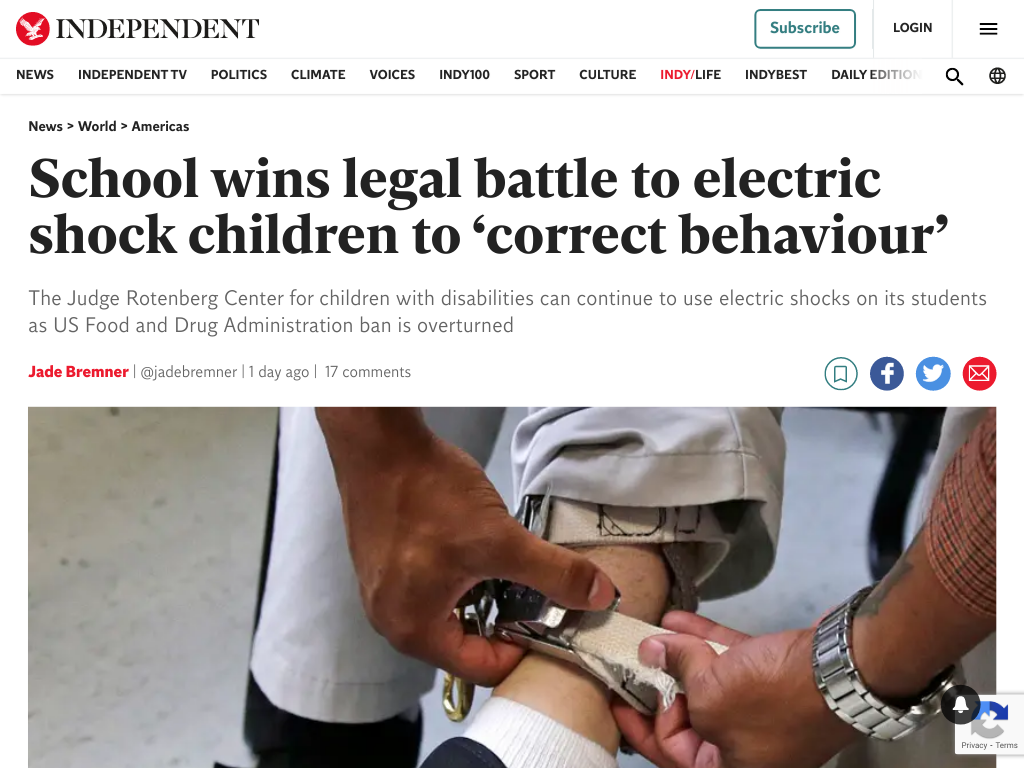A federal court of appeals ruled on Tuesday that a Massachusetts school for children with disabilities can continue administering electric shocks to its students.
The US Food and Drug Administration (FDA) had previously banned the electric shock treatment used at the Judge Rotenberg Center, Canton. The institution created the controversial treatment to correct aggressive or self-harming behaviour in adults and children.
The school, along with a group of parents and guardians of students, had challenged the previous FDA ban. The court of appeals for the DC Circuit found that the treatment falls into medical regulations and therefore is beyond the FDA’s remit of control.
“With the treatment, these residents can continue to participate in enriching experiences, enjoy visits with their families and, most importantly, live in safety and freedom from self-injurious and aggressive behaviours,” the school said in a statement following the ruling.
“We have and will continue to fight to keep our loved ones safe and alive and to retain access to this life-saving treatment of last resort,” parents of the students added in a statement.
The Judge Rotenberg Center, Canton, is the only school in the US that uses electric shock treatment on its students, and has suffered heavy criticism from disability rights advocates, including Mental Disability Rights International (DRI) and the United Nations, which considers the practice “torture”.
“The idea of using electric shocks to torture children has been recognised as unconscionable around the world,” DRI’s president, Laurie Ahern, told the Guardian.
“The real torture is what these children are subjected to if they don’t have this programme,” institute and treatment founder Matthew Israel previously said to ABC News.
“They’re drugged up to the gills with drugs that cause them to be so sedated that they essentially sleep all day.”
There are around 300 students, including 48 overnight residents, at the Judge Rotenberg Center. According to Massachusetts News, about 55 of these are approved for the Graduated Electronic Decelerator shock devices, which remotely administer a powerful shock to the wearer’s skin.
“One client of ours is a woman who hit her head against the wall so many times that her retinas were detached,” said Attorney Max Stern, who represents the parents and guardians of Judge Rotenberg Center.
“It was not until she went to multiple various other institutions, not until she got to JRC and got this treatment that she was able to get this behaviour under control so she could have surgery to make it possible for her to see again,” Stern told Massachusetts News.
However, a 2006 report by the New York State Education Department found that the device was regularly used for minor disobedience and “behaviours that are not aggressive, health dangerous or destructive, such as nag*ing, swearing and failing to maintain a neat appearance”.
The report also found no evidence that the school “considers the potential negative effects, such as depression or anxiety, that may result from the use of aversive behavioural strategies with certain individual students”.
The school claims on its website that it “has provided very effective education and treatment to both emotionally disturbed students with conduct, behaviour, emotional, and/or psychiatric problems, as well as those with intellectual disabilities or on the autism spectrum”.
The Independent has contacted Judge Rotenberg Center for further comment.



I used to work with a teenager who had very very severe self-injurious behavior.
Keeping him safe was a lot of work, I'm not going to claim it wasn't. You know how we did it? We treated him like a fucking human being and tried to find A) ways to prevent him from hurting himself that didn't infringe on his rights and B) ways to help him meet his needs so that he didn't experience the compulsion to self harm as often. You know what we didn't do? Torture him.
Thank you. I was looking at this shit like, surely these are not the only two options:
deleted by creator
I will concede one thing- I have to be vague about this, but there was one particular measure that we took that, from the outside, would certainly look restrictive and inhumane (it was not either of the things in your comment). However, it was only done with the recognition that the alternative was that he would seriously injure himeslf, and it was done with a plan to reduce it as quickly as we possibly could- and then it turned out that he liked it, and part of our plan to reduce it then had to include figuring out how to give him a way to ask for the more serious version of it when he wanted it (he was nonverbal, but very savvy about communicating his needs if you went in understanding that that was what he was doing), as well as finding ways to provide the psychological effect that those measures gave him without the restrictive aspect.
And a significant part of it was also ABA. ABA rightly has a really awful reputation for being tantamount to torture, but this specific case showed me it can be done humanely, if you A) don't use it to discourage behaviors that aren't actually harmful (e.g stimming), B) use as light a touch as possible, and C) do it with methodology based around empowering the person as much as possible, in this case by helping to give him as many ways to communicate as possible and getting his thoughts and feelings about what we did to the highest degree we could.